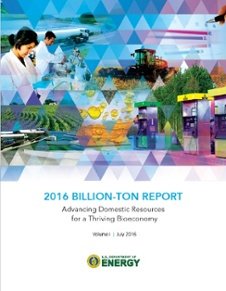 The2016 Billion-Ton Reportjointly released by the U.S. Department of Energy and Oak Ridge National Laboratory this week has found that the United States has the potential to sustainably produce at least 1 billion dry tons of non-food biomass resources annually by 2040. These renewable resources include agricultural, forestry and algal biomass, as well as waste.
The2016 Billion-Ton Reportjointly released by the U.S. Department of Energy and Oak Ridge National Laboratory this week has found that the United States has the potential to sustainably produce at least 1 billion dry tons of non-food biomass resources annually by 2040. These renewable resources include agricultural, forestry and algal biomass, as well as waste.
They encompass the current and future potential of biomass, from currently available logging and crop residues to future available algae and dedicated energy cropsall useable for the production of biofuel, bio-power and bio-products.
The report,findings show that under a base-case scenario, the United States could increase its use of dry biomass resources from a current 400 million tons to 1.57 billion tons under a high-yield scenario.
Increasing production and use of biofuel, bio-power and bio-based products would substantially decrease greenhouse gas emissions in the utility and transportation sectors and reduce U.S. dependence on imported oil as the domestic bio-economy grows.
New to the 2016 report are assessments of potential biomass supplies from algae, from new energy crops (miscanthus, energy cane, eucalyptus), and from municipal solid waste. For the first time, the report also considers how the cost of pre-processing and transporting biomass to the biorefinery may impact feedstock availability.
The analysis was led by ORNL ( @ORNL)with contributions from 65 experts from federal agencies such as the U.S. Forest Service, Department of Agriculture, Environmental Protection Agency, Department of Transportation and Federal Aviation Administration, as well as national laboratories (Idaho National Laboratory, the National Renewable Energy Laboratory and Pacific Northwest National Laboratory), and universities (the University of Tennessee, North Carolina State University, South Dakota State University and Oregon State University), as well as private companies (Energetics, Inc. and Allegheny Science and Technology).
Interactive toolsavailable through theBioenergy Knowledge Discovery Frameworkallow users to visualize biomass availability scenarios andtailor the data by factors such as geographic area, biomass source and price. Researchers and decision makers can use these features to better inform national bioenergy policies and research, development and deployment strategies. Each diagram and map in the report is available in an interactive interface on theBioenergy Knowledge Discovery Framework.
The2016 Billion-Ton Report, volume 1, updates and expands upon analysis in the2011U.S. Billion-Ton Update, which was preceded by the2005U.S. Billion Ton Study.. The report uses scientific modeling systems to project biomass resource availability under specified economic and sustainability constraints.
Volume 2 of the report is set for release later this year, and will consist of a collection of analyses on the potential environmental sustainability effects of a subset of agricultural and forestry biomass production scenarios presented in volume 1. Volume 2 will also discuss algae sustainability, land use and land management changes, and strategies to enhance environmental sustainability.
Bio-Based Live is coming to San Francisco onSeptember 26-27th 2016, for all the latest information and to find out how you can become involved, contact Dan@BioBasedWorldNews.com
Interested in this bio-based development? Then you may also like…





